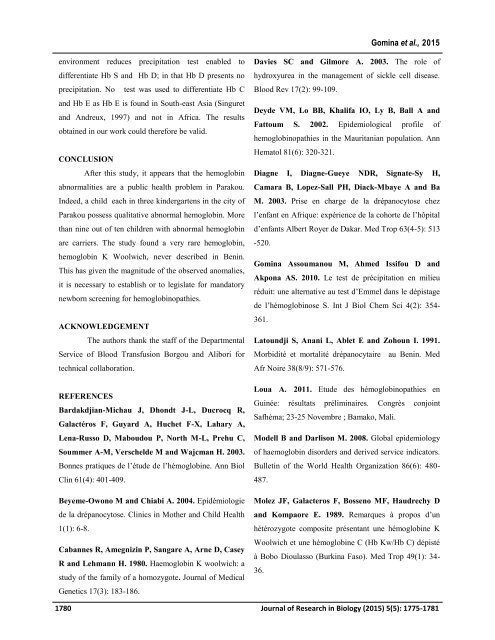Prevalence of hemoglobin abnormalities in kindergartens of the city of Parakou (Benin) in 2013
Introduction: The hemoglobinopathy is a real public health problem in the world The aim of this study to épister of children with abnormalities of hemoglobin in schools, especially kindergartens in the city of Parakou Republic of Benin. Methods: This is a descriptive cross-sectional study, conducted in kindergartens in the city of Parakou in Benin republic and having concerned 690 children aged 2 ½ to 5 years. The hemoglobin electrophoresis was done using alkaline pH hydragel and the quantification of haemoglobin fractions were performed with Hyrys densitometer; in some cases the medium is reduced for precipitation test. Results: Five types of Hb were identified: A, S, M, C and K probably Woolwich. Qualitative hemoglobinopathy was found in 31.45% of the study population. The Hb-S was the most frequent (16.52%) followed by hemoglobin C (15.65%). Hereditary persistence of hemoglobin F was associated with phenotypes AA, AC and SS in 1.16% of cases. The hemoglobinopathies were found in all the major ethnic groups in Parakou with a clear predominance among "Lokpa" (53.3%) and "Adja" (37.5%). Conclusion: The hemoglobinopathy is a real public health problem in Parakou, it is necessary to establish or to legislate for mandatory testing for hemoglobinopathies at birth.
Introduction: The hemoglobinopathy is a real public health problem in the world The aim of this study to épister of children with abnormalities of hemoglobin in schools, especially kindergartens in the city of Parakou Republic of Benin.
Methods: This is a descriptive cross-sectional study, conducted in kindergartens in the city of Parakou in Benin republic and having concerned 690 children aged 2 ½ to 5 years. The hemoglobin electrophoresis was done using alkaline pH hydragel and the quantification of haemoglobin fractions were performed with Hyrys densitometer; in some cases the medium is reduced for precipitation test.
Results: Five types of Hb were identified: A, S, M, C and K probably Woolwich. Qualitative hemoglobinopathy was found in 31.45% of the study population. The Hb-S was the most frequent (16.52%) followed by hemoglobin C (15.65%). Hereditary persistence of hemoglobin F was associated with phenotypes AA, AC and SS in 1.16% of cases. The hemoglobinopathies were found in all the major ethnic groups in Parakou with a clear predominance among "Lokpa" (53.3%) and "Adja" (37.5%).
Conclusion: The hemoglobinopathy is a real public health problem in Parakou, it is necessary to establish or to legislate for mandatory testing for hemoglobinopathies at birth.
You also want an ePaper? Increase the reach of your titles
YUMPU automatically turns print PDFs into web optimized ePapers that Google loves.
Gom<strong>in</strong>a et al., 2015<br />
environment reduces precipitation test enabled to<br />
differentiate Hb S and Hb D; <strong>in</strong> that Hb D presents no<br />
precipitation. No test was used to differentiate Hb C<br />
and Hb E as Hb E is found <strong>in</strong> South-east Asia (S<strong>in</strong>guret<br />
and Andreux, 1997) and not <strong>in</strong> Africa. The results<br />
obta<strong>in</strong>ed <strong>in</strong> our work could <strong>the</strong>refore be valid.<br />
CONCLUSION<br />
After this study, it appears that <strong>the</strong> <strong>hemoglob<strong>in</strong></strong><br />
<strong>abnormalities</strong> are a public health problem <strong>in</strong> <strong>Parakou</strong>.<br />
Indeed, a child each <strong>in</strong> three k<strong>in</strong>dergartens <strong>in</strong> <strong>the</strong> <strong>city</strong> <strong>of</strong><br />
<strong>Parakou</strong> possess qualitative abnormal <strong>hemoglob<strong>in</strong></strong>. More<br />
than n<strong>in</strong>e out <strong>of</strong> ten children with abnormal <strong>hemoglob<strong>in</strong></strong><br />
are carriers. The study found a very rare <strong>hemoglob<strong>in</strong></strong>,<br />
<strong>hemoglob<strong>in</strong></strong> K Woolwich, never described <strong>in</strong> Ben<strong>in</strong>.<br />
This has given <strong>the</strong> magnitude <strong>of</strong> <strong>the</strong> observed anomalies,<br />
it is necessary to establish or to legislate for mandatory<br />
newborn screen<strong>in</strong>g for <strong>hemoglob<strong>in</strong></strong>opathies.<br />
ACKNOWLEDGEMENT<br />
The authors thank <strong>the</strong> staff <strong>of</strong> <strong>the</strong> Departmental<br />
Service <strong>of</strong> Blood Transfusion Borgou and Alibori for<br />
technical collaboration.<br />
REFERENCES<br />
Bardakdjian-Michau J, Dhondt J-L, Ducrocq R,<br />
Galactéros F, Guyard A, Huchet F-X, Lahary A,<br />
Lena-Russo D, Maboudou P, North M-L, Prehu C,<br />
Soummer A-M, Verschelde M and Wajcman H. 2003.<br />
Bonnes pratiques de l’étude de l’hémoglob<strong>in</strong>e. Ann Biol<br />
Cl<strong>in</strong> 61(4): 401-409.<br />
Beyeme-Owono M and Chiabi A. 2004. Epidémiologie<br />
de la drépanocytose. Cl<strong>in</strong>ics <strong>in</strong> Mo<strong>the</strong>r and Child Health<br />
1(1): 6-8.<br />
Cabannes R, Amegniz<strong>in</strong> P, Sangare A, Arne D, Casey<br />
R and Lehmann H. 1980. Haemoglob<strong>in</strong> K woolwich: a<br />
study <strong>of</strong> <strong>the</strong> family <strong>of</strong> a homozygote. Journal <strong>of</strong> Medical<br />
Genetics 17(3): 183-186.<br />
Davies SC and Gilmore A. 2003. The role <strong>of</strong><br />
hydroxyurea <strong>in</strong> <strong>the</strong> management <strong>of</strong> sickle cell disease.<br />
Blood Rev 17(2): 99-109.<br />
Deyde VM, Lo BB, Khalifa IO, Ly B, Ball A and<br />
Fattoum S. 2002. Epidemiological pr<strong>of</strong>ile <strong>of</strong><br />
<strong>hemoglob<strong>in</strong></strong>opathies <strong>in</strong> <strong>the</strong> Mauritanian population. Ann<br />
Hematol 81(6): 320-321.<br />
Diagne I, Diagne-Gueye NDR, Signate-Sy H,<br />
Camara B, Lopez-Sall PH, Diack-Mbaye A and Ba<br />
M. 2003. Prise en charge de la drépanocytose chez<br />
l’enfant en Afrique: expérience de la cohorte de l’hôpital<br />
d’enfants Albert Royer de Dakar. Med Trop 63(4-5): 513<br />
-520.<br />
Gom<strong>in</strong>a Assoumanou M, Ahmed Issifou D and<br />
Akpona AS. 2010. Le test de précipitation en milieu<br />
réduit: une alternative au test d’Emmel dans le dépistage<br />
de l’hémoglob<strong>in</strong>ose S. Int J Biol Chem Sci 4(2): 354-<br />
361.<br />
Latoundji S, Anani L, Ablet E and Zohoun I. 1991.<br />
Morbidité et mortalité drépanocytaire au Ben<strong>in</strong>. Med<br />
Afr Noire 38(8/9): 571-576.<br />
Loua A. 2011. Etude des hémoglob<strong>in</strong>opathies en<br />
Gu<strong>in</strong>ée: résultats prélim<strong>in</strong>aires. Congrès conjo<strong>in</strong>t<br />
Safhéma; 23-25 Novembre ; Bamako, Mali.<br />
Modell B and Darlison M. 2008. Global epidemiology<br />
<strong>of</strong> haemoglob<strong>in</strong> disorders and derived service <strong>in</strong>dicators.<br />
Bullet<strong>in</strong> <strong>of</strong> <strong>the</strong> World Health Organization 86(6): 480-<br />
487.<br />
Molez JF, Galacteros F, Bosseno MF, Haudrechy D<br />
and Kompaore E. 1989. Remarques à propos d’un<br />
hétérozygote composite présentant une hémoglob<strong>in</strong>e K<br />
Woolwich et une hémoglob<strong>in</strong>e C (Hb Kw/Hb C) dépisté<br />
à Bobo Dioulasso (Burk<strong>in</strong>a Faso). Med Trop 49(1): 34-<br />
36.<br />
1780 Journal <strong>of</strong> Research <strong>in</strong> Biology (2015) 5(5): 1775-1781
















